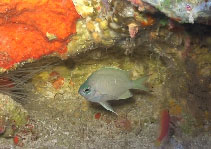| Family: |
Pomacentridae (Damselfishes), subfamily: Chrominae |
| Max. size: |
6.63 cm SL (male/unsexed) |
| Environment: |
reef-associated; marine; depth range 60 - 116 m |
| Distribution: |
Western Pacific: from Puluwat westward to Palau; south to Papua New Guinea, Vanuatu and Fiji; also Indonesia. It was not observed at Rarotonga (Cook Islands), Kiritimati (Line Islands), nor American Samoa during brief surveys of deep reefs at these localities. |
| Diagnosis: |
Dorsal spines (total): 12-13; Dorsal soft rays (total): 11-12; Anal spines: 2-2; Anal soft rays: 12-12. This species is distinguished by the following characters: Dorsal rays XII-XIII, 11-12, usually XIII, 12; anal rays II, 12; pectoral rays 17-18, usually 18; spiniform caudal rays 3; tubed lateral-line scales 13-15, rarely 16; gill rakers 6-8 + 18-21 (total 26-28, rarely 25); body depth 1.65-1.9 in SL. The color when fresh is pale slate blue (bright pale green in life) with a white spot (sometimes two white spots) roughly the size of a scale mid-laterally on the body; malachite green area above orbit and in inter-orbital space and nape; the dorsal and anal fins with bright distal border of pale turquoise blue (Ref. 59379). |
| Biology: |
Adults inhabit steep outer reef slopes and drop-offs with rocky outcrops and small caves and holes, often in association with limestone talus; usually observed in pairs or small groups, feeding low in the water column, and are generally abundant where they are found (Ref. 59379). Oviparous, distinct pairing during breeding (Ref. 205). Eggs are demersal and adhere to the substrate (Ref. 205). Males guard and aerate the eggs (Ref. 205). |
| IUCN Red List Status: |
Least Concern (LC); Date assessed: 18 August 2023 Ref. (130435)
|
| Threat to humans: |
harmless |
Source and more info: www.fishbase.org. For personal, classroom, and other internal use only. Not for publication.
